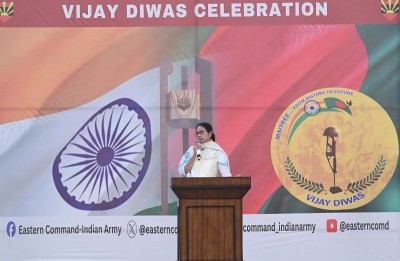 India-China
India-China
India, China have completed disengagement: Reports
India and China have disengaged in the Depsang and Demchok regions of Eastern Ladakh, keeping track of the timeline that was announced earlier.
Indian Army sources told NDTV that sweets will also be exchanged with troops from the Chinese side on the occasion of Diwali on Thursday.
Sources from the Indian Army told the news channel that the verification process is on and the modalities of patrolling will be decided by the ground commanders.
For over four years, the two countries were engaged in a military standoff along the Line of Actual Control (LAC) following the Galwan clash which took place in June 2020.
Last month, India and China reached a consensus and agreed to disengage along the border "in a coordinated and planned way".
Both the armies had agreed to withdraw from their positions to their respective positions on their sides and verify each others' positions after that.
Speaking on the agreement, Vikram Misry, the foreign secretary of India, had said as quoted by The Hindu, "Over the last several weeks, Indian and Chinese diplomatic and military negotiators have been in close contact with each other in a variety of forums, and as a result of these discussions, agreement has been arrived at on patrolling arrangements along the Line of Actual Control in the India-China border areas, leading to disengagement and a resolution of the issues that had arisen in these areas in 2020."
Chinese Foreign Ministry spokesperson Mao Ning had said as quoted by India Today, "The China-India border situation is generally stable and under control."
Exuding confidence in achieving full resolution, India's External Affairs Minister S Jaishankar had said 75 percent of the issues in the region of dispute have been addressed.
Galwan Clash
The Galwan skirmish erupted from a dispute over a temporary bridge built by the Chinese in the Galwan River valley in Ladakh.
On June 15, 2020, Indian and Chinese troops engaged in a six-hour clash in the rugged terrain of Ladakh, engaging in hand-to-hand combat with makeshift weapons such as stones, batons, and iron rods.
The face-off occurred in near-complete darkness and freezing temperatures, leading to fatalities as soldiers fell or were pushed from ridges.
Twenty Indian soldiers were martyred in the clash, while China officially acknowledged four casualties, although reports indicate higher Chinese losses, as soldiers drowned in the choppy waters of the Galwan River.
Among the Indians, Colonel B Santosh Babu, the Commanding Officer of the 16th Bihar Regiment, was martyred during the unprovoked aggression by PLA troops.
The Galwan clashes highlighted China's aggressive stance towards its neighbouring countries.
Many observers on social media noted similarities between the Chinese attack on Philippine navy ships and the 2020 Galwan Valley clash.
Support Our Journalism
We cannot do without you.. your contribution supports unbiased journalism
IBNS is not driven by any ism- not wokeism, not racism, not skewed secularism, not hyper right-wing or left liberal ideals, nor by any hardline religious beliefs or hyper nationalism. We want to serve you good old objective news, as they are. We do not judge or preach. We let people decide for themselves. We only try to present factual and well-sourced news.







